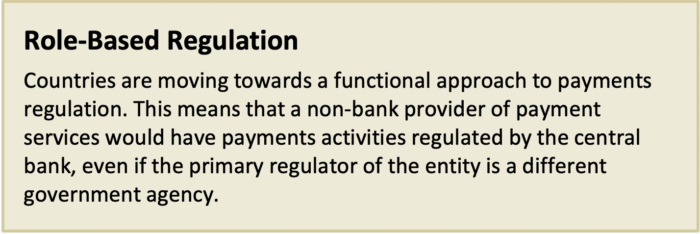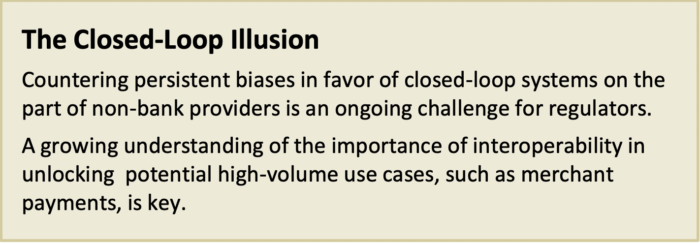What Regulatory Support is Critical for a Thriving Digital Ecosystem?
Support for the financial ecosystem by regulators is necessary at many levels. Three aspects are of particular importance in ensuring scale.
1. Enabling DFSPs that Can Reach the Poor
It is well understood that traditional banking models don’t work economically to serve the poor. This is a problem that has to be solved to reach financial inclusion goals. Several regulatory licensing approaches are relevant and worth consideration:
eMoney Issuance: Regulators give permissions for new categories of providers to offer transaction accounts. Often, but not always, eMoney Issuance licenses are given to MNO’s, which have extensive customer relationships and agent networks. In some countries, banks are also asked to become eMoney Issuers if they want to participate in eMoney interoperability schemes.
Special Purpose Banks: In some countries, new types of bank charters are issued, intended to allow non-bank entities to provide transaction accounts.

2. Supporting DFSP Interoperability
A core design principle of Level One is interoperability among DFPSs. In many markets, this has been resisted by some DFSPs, who like the economic models of closed-loop wallets. In other markets, interoperability has been enabled among banks alone or among eMoney Issuers alone, but not among DFSPs of all categories.
Regulators have taken a variety of approaches to encourage interoperability, from mandating participation to encouraging it. Two trends are of particular interest:
In markets such as Mexico, the central bank ensures interoperability by both operating the real-time retail payments switch, and by enabling it to be used (by QR codes) for merchant payments. Central banks express interest in this model because it can also provide regulatory visibility into payments transactions.
Centralized national directories play an important role in making interoperability work, with the potential to reduce fraud. Australia’s PayID and Tanzania’s Financial Services Registry are interesting examples.
In some countries or regions, it appears that there will be multiple RTRP systems: in this case, cross-system interoperability will be necessary to achieve ubiquity.

3. Enabling Third Party Connections
As mentioned, specialty aggregators, processors, and other entities operate today in many markets and serve an important role in facilitating access and use-case specific payments. Regulators have taken various approaches to ensure that third parties can participate in the ecosystem without adding substantial risk.
PSPs as Payment Initiators: In India, a new class of non-bank players, called PSPs (or Payment Service Providers), have been given a role in the UPI payment system. The PSP can, on behalf of a customer, create a payment order that moves money from their customer’s bank account to another bank account. This unique structure separates the transaction authentication and authorization processes into two components, which are shared between the PSP and the bank. This approach is in Europe with PSD2.
Next Topic in this Section: What Else is Necessary to Reach Scale?
